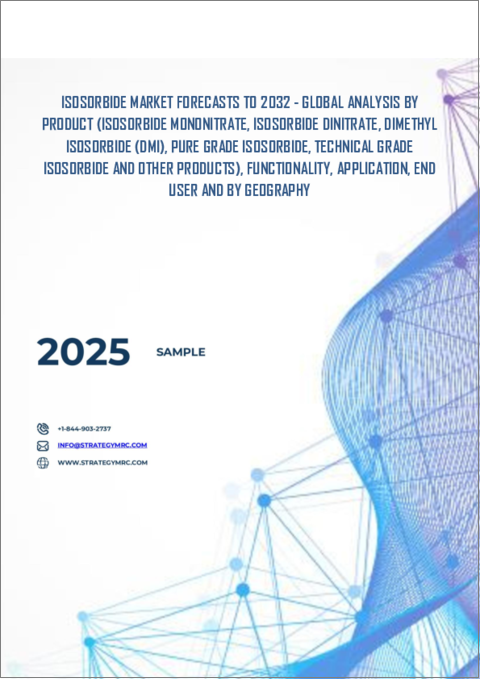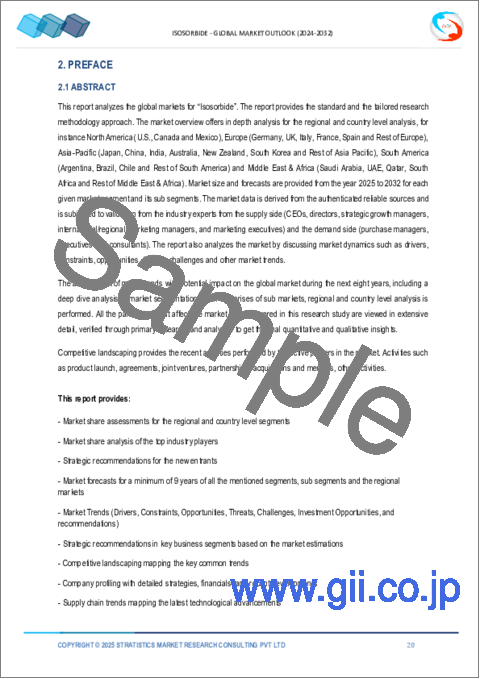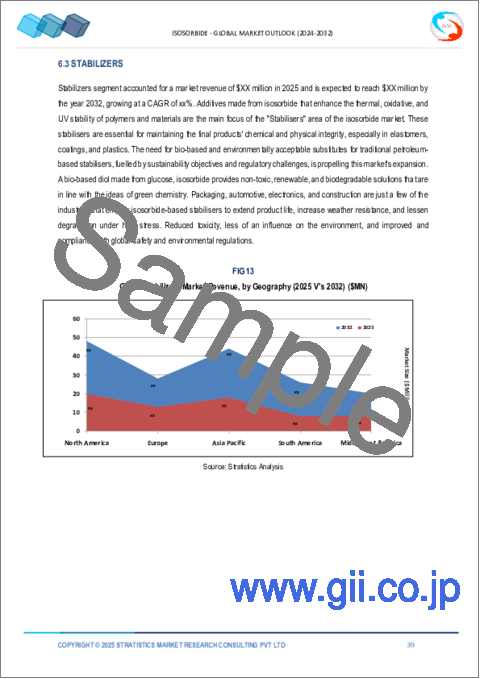|
|
市場調査レポート
商品コード
1625172
イソソルビドの2030年までの市場予測:製品別、機能別、用途別、エンドユーザー別、地域別の世界分析Isosorbide Market Forecasts to 2030 - Global Analysis By Product, Functionality, Application, End User and By Geography |
||||||
カスタマイズ可能
|
|||||||
| イソソルビドの2030年までの市場予測:製品別、機能別、用途別、エンドユーザー別、地域別の世界分析 |
|
出版日: 2025年01月01日
発行: Stratistics Market Research Consulting
ページ情報: 英文 200+ Pages
納期: 2~3営業日
|
全表示
- 概要
- 図表
- 目次
Stratistics MRCによると、イソソルビドの世界市場は2024年に8億2,000万米ドルを占め、予測期間中にCAGR 11.2%で成長し、2030年には15億8,000万米ドルに達すると予想されています。
イソソルビドはグルコースに由来する二環式有機化合物です。イソソルビドは、再生可能な生分解性代替物質として、ポリマー、特にポリエステルなどのバイオプラスチックの生産に一般的に使用されています。イソソルビドは、糖アルコールの一種であるソルビトールの脱水反応によって製造されます。イソソルビドをベースとする材料は、高い熱安定性と機械的特性で知られています。
生分解性プラスチックへの需要の高まり
プラスチック廃棄物に対する環境への懸念が高まる中、産業界は環境に優しい代替品へのシフトを進めています。再生可能資源に由来するイソソルビドは、包装、自動車部品、消費財に使用される高性能プラスチックを製造するための生分解性選択肢を提供します。プラスチック廃棄物の削減と再生可能素材の採用を促進する政府規制が、需要をさらに押し上げています。その結果、持続可能性を求める動きが強まり、イソソルビド系プラスチックの採用が加速し、市場は世界的に拡大しています。
大規模生産における技術的障壁
イソソルビドの大規模生産における技術的障壁は、生産工程の複雑さとコストに起因します。現在の方法では、特殊な装置、高いエネルギー消費、高価な触媒が必要な場合が多く、大規模生産が経済的に実行可能であるとは言い難いです。さらに、小規模のラボプロセスでは直接的にスケールアップできない場合があるため、大規模で安定した品質と収率を達成することは困難です。これらの要因は、生産コストの上昇と生産能力の限界につながり、イソソルビドベースの製品の普及を妨げています。
生化学技術の進歩
生物触媒や発酵ベースの方法などの革新的なプロセスは、グルコースやソルビトールのような再生可能な原料のイソソルビドへの持続可能でコスト効率の高い変換を可能にします。また、これらの技術はイソソルビドの純度と収率を高め、バイオプラスチック、医薬品、自動車などさまざまな産業にとってより魅力的な選択肢となります。さらに、酵素プロセスにおける画期的な進歩は、より環境に優しいアプローチを可能にし、持続可能で環境に優しい材料に対する需要の高まりに合致するため、世界の市場拡大をさらに後押ししています。
代替材料の入手可能性
従来のプラスチックや石油化学ベースの材料は、イソソルビドをベースとするバイオプラスチックよりも安価で容易に入手できることが多いため、環境面での利点があるにもかかわらず、産業界がイソソルビドを採用することを躊躇する可能性があります。さらに、ポリ乳酸(PLA)やポリエチレンテレフタレート(PET)といった他のバイオベースの代替材料は、包装や自動車などの用途で競合しており、イソソルビドの普及を制限しています。この競合が、特定の分野での市場の成長と採用を遅らせています。
COVID-19の影響
COVID-19パンデミックはイソソルビド市場に様々な影響を与えました。サプライチェーンの混乱と産業活動の低下により、生産と需要が一時的に鈍化しました。その一方で、パンデミックの間に持続可能な解決策への関心が高まったことで、生分解性プラスチックや再生可能素材への関心が高まり、イソソルビド需要を押し上げました。医薬品分野でも、この危機の間、心臓病の治療薬などイソソルビドを主成分とする製品の需要が続きました。
予測期間中、硝酸イソソルビドセグメントが最大となる見込み
硝酸イソソルビドセグメントは予測期間を通じて最大の市場シェアを確保すると予測されます。硝酸イソソルビドは、血管拡張薬として作用することで、主に狭心症(胸痛)や心不全の治療に用いられる薬剤です。血管を弛緩させ広げることで作用し、心臓の負担を減らして血流を改善します。心血管系疾患の治療に有効であることから、心臓病管理における重要な要素となっています。
ヘルスケア分野は予測期間中に最も高いCAGRが見込まれる
ヘルスケア分野は予測期間中に最も高いCAGRが見込まれます。イソソルビドは、特に心血管疾患の治療において重要なヘルスケア用途を有しています。誘導体である硝酸イソソルビドは、血管を弛緩させ血流を改善することで狭心症や心不全を治療する血管拡張剤として一般的に使用されています。イソソルビドは直接的な医薬品用途以外にも、ドラッグデリバリーシステムや、その生体適合性から持続可能な生分解性医療機器開発のプラットフォームとしての可能性も模索されています。
最大のシェアを占める地域
アジア太平洋地域は、特に中国、インド、日本などの国々で持続可能なバイオプラスチックに対する需要が高まっていることから、予測期間中に最大の市場シェアを記録すると予想されます。同地域では、政府のイニシアティブにより、環境に優しい代替品が促進されています。Mitsubishi Chemical Corporation、DuPont、Archer Daniels Midland Companyなどの主要企業が、イソソルビドをベースとした製品の生産と開発で主導権を握っています。産業用途の増加と環境意識の高まりにより、この地域の市場は今後数年間で大きな成長が見込まれます。
CAGRが最も高い地域:
北米は、包装、自動車、消費財などの産業における需要の増加に後押しされ、予測期間中に最も高いCAGRを記録すると予想されます。プラスチック廃棄物の削減と再生可能材料の促進に関する政府の強力な規制が市場をさらに後押ししています。この地域の主なプレーヤーには、ADM、DuPont、BioAmberなどがあり、イソソルビドベースのソリューション開発を進めています。グリーン技術や環境に優しい製品へのシフトが進む中、北米のイソソルビド市場は今後数年で着実に拡大すると予想されます。
無料のカスタマイズサービス
本レポートをご購読のお客様には、以下の無料カスタマイズオプションのいずれかをご利用いただけます:
- 企業プロファイル
- 追加市場プレイヤーの包括的プロファイリング(3社まで)
- 主要企業のSWOT分析(3社まで)
- 地域セグメンテーション
- 顧客の関心に応じた主要国の市場推計・予測・CAGR(注:フィージビリティチェックによる)
- 競合ベンチマーキング
- 製品ポートフォリオ、地理的プレゼンス、戦略的提携に基づく主要企業のベンチマーキング
目次
第1章 エグゼクティブサマリー
第2章 序文
- 概要
- ステークホルダー
- 調査範囲
- 調査手法
- データマイニング
- データ分析
- データ検証
- 調査アプローチ
- 調査情報源
- 1次調査情報源
- 2次調査情報源
- 前提条件
第3章 市場動向分析
- 促進要因
- 抑制要因
- 機会
- 脅威
- 製品分析
- 用途分析
- エンドユーザー分析
- 新興市場
- COVID-19の影響
第4章 ポーターのファイブフォース分析
- 供給企業の交渉力
- 買い手の交渉力
- 代替品の脅威
- 新規参入業者の脅威
- 競争企業間の敵対関係
第5章 世界のイソソルビド市場:製品別
- 一硝酸イソソルビド
- 硝酸イソソルビド
- ジメチルイソソルビド(DMI)
- ピュアグレードイソソルビド
- テクニカルグレードイソソルビド
- その他の製品
第6章 世界のイソソルビド市場:機能別
- 可塑剤
- 安定剤
- 中間体
- 添加物
- その他の機能
第7章 世界のイソソルビド市場:用途別
- ポリマーと樹脂
- ポリカーボネート
- ポリエステル
- ポリウレタン
- エポキシ樹脂
- 医薬品有効成分(API)
- 薬剤処方
- 甘味料
- 包装資材
- その他の用途
第8章 世界のイソソルビド市場:エンドユーザー別
- 自動車
- 建設
- ヘルスケア
- 化粧品
- 食品・飲料
- エレクトロニクス
- その他のエンドユーザー
第9章 世界のイソソルビド市場:地域別
- 北米
- 米国
- カナダ
- メキシコ
- 欧州
- ドイツ
- 英国
- イタリア
- フランス
- スペイン
- その他欧州
- アジア太平洋
- 日本
- 中国
- インド
- オーストラリア
- ニュージーランド
- 韓国
- その他アジア太平洋地域
- 南米
- アルゼンチン
- ブラジル
- チリ
- その他南米
- 中東・アフリカ
- サウジアラビア
- アラブ首長国連邦
- カタール
- 南アフリカ
- その他中東とアフリカ
第10章 主な発展
- 契約、パートナーシップ、コラボレーション、合弁事業
- 買収と合併
- 新製品発売
- 事業拡大
- その他の主要戦略
第11章 企業プロファイリング
- Mitsubishi Chemical Corporation
- Alfa Aesar
- Tokyo Chemical Corporation
- Thermo Fisher Scientific
- Chemsky International
- Arkema S.A.
- SK Chemicals Corporation
- Sigma-Aldrich Corporation
- Chemscene LLC
- DuPont
- Roquette Freres
- ADM Corporation
- Parchem Fine & Specialty Chemicals
- Ecogreen Oleochemicals
- Archer Daniels Midland Company
- Zydus Lifesciences
List of Tables
- Table 1 Global Isosorbide Market Outlook, By Region (2022-2030) ($MN)
- Table 2 Global Isosorbide Market Outlook, By Product (2022-2030) ($MN)
- Table 3 Global Isosorbide Market Outlook, By Isosorbide Mononitrate (2022-2030) ($MN)
- Table 4 Global Isosorbide Market Outlook, By Isosorbide Dinitrate (2022-2030) ($MN)
- Table 5 Global Isosorbide Market Outlook, By Dimethyl Isosorbide (DMI) (2022-2030) ($MN)
- Table 6 Global Isosorbide Market Outlook, By Pure Grade Isosorbide (2022-2030) ($MN)
- Table 7 Global Isosorbide Market Outlook, By Technical Grade Isosorbide (2022-2030) ($MN)
- Table 8 Global Isosorbide Market Outlook, By Other Products (2022-2030) ($MN)
- Table 9 Global Isosorbide Market Outlook, By Functionality (2022-2030) ($MN)
- Table 10 Global Isosorbide Market Outlook, By Plasticizers (2022-2030) ($MN)
- Table 11 Global Isosorbide Market Outlook, By Stabilizers (2022-2030) ($MN)
- Table 12 Global Isosorbide Market Outlook, By Intermediates (2022-2030) ($MN)
- Table 13 Global Isosorbide Market Outlook, By Additives (2022-2030) ($MN)
- Table 14 Global Isosorbide Market Outlook, By Other Functionalities (2022-2030) ($MN)
- Table 15 Global Isosorbide Market Outlook, By Application (2022-2030) ($MN)
- Table 16 Global Isosorbide Market Outlook, By Polymers & Resins (2022-2030) ($MN)
- Table 17 Global Isosorbide Market Outlook, By Polycarbonate (2022-2030) ($MN)
- Table 18 Global Isosorbide Market Outlook, By Polyester (2022-2030) ($MN)
- Table 19 Global Isosorbide Market Outlook, By Polyurethane (2022-2030) ($MN)
- Table 20 Global Isosorbide Market Outlook, By Epoxy Resins (2022-2030) ($MN)
- Table 21 Global Isosorbide Market Outlook, By Active Pharmaceutical Ingredients (APIs) (2022-2030) ($MN)
- Table 22 Global Isosorbide Market Outlook, By Drug Formulations (2022-2030) ($MN)
- Table 23 Global Isosorbide Market Outlook, By Sweeteners (2022-2030) ($MN)
- Table 24 Global Isosorbide Market Outlook, By Packaging Materials (2022-2030) ($MN)
- Table 25 Global Isosorbide Market Outlook, By Other Applications (2022-2030) ($MN)
- Table 26 Global Isosorbide Market Outlook, By End User (2022-2030) ($MN)
- Table 27 Global Isosorbide Market Outlook, By Automotive (2022-2030) ($MN)
- Table 28 Global Isosorbide Market Outlook, By Construction (2022-2030) ($MN)
- Table 29 Global Isosorbide Market Outlook, By Healthcare (2022-2030) ($MN)
- Table 30 Global Isosorbide Market Outlook, By Cosmetics (2022-2030) ($MN)
- Table 31 Global Isosorbide Market Outlook, By Food & Beverages (2022-2030) ($MN)
- Table 32 Global Isosorbide Market Outlook, By Electronics (2022-2030) ($MN)
- Table 33 Global Isosorbide Market Outlook, By Other End Users (2022-2030) ($MN)
Note: Tables for North America, Europe, APAC, South America, and Middle East & Africa Regions are also represented in the same manner as above.
According to Stratistics MRC, the Global Isosorbide Market is accounted for $0.82 billion in 2024 and is expected to reach $1.58 billion by 2030 growing at a CAGR of 11.2% during the forecast period. Isosorbide is a bicyclic organic compound derived from glucose. It is commonly used as a renewable, biodegradable alternative in the production of polymers, particularly in bioplastics, such as polyesters. Isosorbide is produced through the dehydration of sorbitol, a sugar alcohol. Isosorbide-based materials are known for their high thermal stability and mechanical properties.
Market Dynamics:
Driver:
Rising demand for biodegradable plastics
With increasing environmental concerns over plastic waste, industries are shifting towards eco-friendly alternatives. Isosorbide, derived from renewable resources, provides a biodegradable option for producing high-performance plastics used in packaging, automotive parts, and consumer goods. Government regulations promoting the reduction of plastic waste and the adoption of renewable materials further drive demand. As a result, the growing push for sustainability accelerates the adoption of isosorbide-based plastics, expanding its market globally.
Restraint:
Technological barriers in large-scale production
Technological barriers in large-scale production of isosorbide stem from the complexity and cost of the production process. Current methods often require specialized equipment, high energy consumption, and expensive catalysts, making large-scale production less economically viable. Additionally, achieving consistent quality and yield at a larger scale is challenging, as small-scale lab processes may not be directly scalable. These factors contribute to higher production costs and limited capacity, which hampers the widespread adoption of isosorbide-based products.
Opportunity:
Advancements in biochemical technologies
Innovative processes, such as biocatalysis and fermentation-based methods, enable the sustainable and cost-effective conversion of renewable feedstocks like glucose and sorbitol into isosorbide. These technologies also enhance the purity and yield of isosorbide, making it a more attractive option for various industries, including bioplastics, pharmaceuticals, and automotive. Additionally, breakthroughs in enzymatic processes allow for a more eco-friendly approach, aligning with the growing demand for sustainable and green materials, further driving market expansion globally.
Threat:
Availability of alternatives
Traditional plastics and petrochemical-based materials are often less expensive and more readily available than isosorbide-based bioplastics, which can deter industries from adopting isosorbide despite its environmental advantages. Additionally, other bio-based alternatives, such as polylactic acid (PLA) and polyethylene terephthalate (PET), compete in applications like packaging and automotive, limiting the widespread adoption of isosorbide. This competition slows market growth and adoption in certain sectors.
Covid-19 Impact
The covid-19 pandemic had a mixed impact on the isosorbide market. On one hand, disruptions in supply chains and reduced industrial activities led to a temporary slowdown in production and demand. On the other hand, the growing focus on sustainable solutions during the pandemic led to increased interest in biodegradable plastics and renewable materials, boosting the demand for isosorbide. The pharmaceutical sector also saw continued demand for isosorbide-based products, such as heart medications, during the crisis.
The isosorbide dinitrate segment is expected to be the largest during the forecast period
The isosorbide dinitrate segment is predicted to secure the largest market share throughout the forecast period. Isosorbide dinitrate is a medication used primarily to treat angina pectoris (chest pain) and heart failure by acting as a vasodilator. It works by relaxing and widening blood vessels, which reduces the heart's workload and improves blood flow. Its effectiveness in treating cardiovascular conditions makes it a crucial component in heart disease management.
The healthcare segment is expected to have the highest CAGR during the forecast period
The healthcare segment is anticipated to witness the highest CAGR during the forecast period. Isosorbide has significant healthcare applications, particularly in the treatment of cardiovascular conditions. Isosorbide dinitrate, a derivative, is commonly used as a vasodilator to manage angina and heart failure by relaxing blood vessels and improving blood flow. Beyond its direct pharmaceutical uses, isosorbide is also explored in drug delivery systems and as a potential platform for the development of sustainable, biodegradable medical devices due to its biocompatibility.
Region with largest share:
Asia Pacific is expected to register the largest market share during the forecast period driven by rising demand for sustainable bioplastics, particularly in countries like China, India, and Japan. Government initiatives in the region are promoting eco-friendly alternatives. Major companies, including Mitsubishi Chemical Corporation, DuPont, and Archer Daniels Midland Company, are leading in the production and development of isosorbide-based products. With increasing industrial applications and environmental awareness, the market in this region is expected to witness significant growth in the coming years.
Region with highest CAGR:
North America is expected to witness the highest CAGR over the forecast period fuelled by increasing demand in industries such as packaging, automotive, and consumer goods. Strong government regulations on reducing plastic waste and promoting renewable materials further propel the market. Key players in the region include ADM, DuPont, and BioAmber, which are advancing the development of isosorbide-based solutions. With a growing shift toward green technologies and environmentally friendly products, the North American isosorbide market is expected to experience steady expansion in the coming years.
Key players in the market
Some of the key players profiled in the Isosorbide Market include Mitsubishi Chemical Corporation, Alfa Aesar, Tokyo Chemical Corporation, Thermo Fisher Scientific, Chemsky International, Arkema S.A., SK Chemicals Corporation, Sigma-Aldrich Corporation, Chemscene LLC, DuPont, Roquette Freres, ADM Corporation, Parchem Fine & Specialty Chemicals, Ecogreen Oleochemicals, Archer Daniels Midland Company and Zydus Lifesciences.
Key Developments:
In November 2024, Roquette Freres advanced its efforts in sustainable chemistry by introducing a new biopolymer-grade isosorbide tailored to meet the growing demand in the packaging and automotive sectors. This innovative product leverages Roquette's expertise in plant-based solutions, offering a bio-based alternative to traditional petroleum-derived materials.
In October 2024, Mitsubishi Chemical Corporation introduced a new isosorbide-based product aimed at enhancing high-performance coatings. This bio-based material is designed to reduce volatile organic compound (VOC) emissions, promoting eco-friendlier coatings. The product offers improved durability and performance in paints, addressing both environmental concerns and the need for superior coating quality.
In February 2024, Zydus Lifesciences received final approval from the U.S. Food and Drug Administration (USFDA) to market Sacubitril and Valsartan tablets, which are prescribed for managing chronic heart failure in adults. These tablets help reduce the risks of death and hospitalization associated with the condition.
Products Covered:
- Isosorbide Mononitrate
- Isosorbide Dinitrate
- Dimethyl Isosorbide (DMI)
- Pure Grade Isosorbide
- Technical Grade Isosorbide
- Other Products
Functionalities Covered:
- Plasticizers
- Stabilizers
- Intermediates
- Additives
- Other Functionalities
Applications Covered:
- Polymers & Resins
- Active Pharmaceutical Ingredients (APIs)
- Drug Formulations
- Sweeteners
- Packaging Materials
- Other Applications
End Users Covered:
- Automotive
- Construction
- Healthcare
- Cosmetics
- Food & Beverages
- Electronics
- Other End Users
Regions Covered:
- North America
- US
- Canada
- Mexico
- Europe
- Germany
- UK
- Italy
- France
- Spain
- Rest of Europe
- Asia Pacific
- Japan
- China
- India
- Australia
- New Zealand
- South Korea
- Rest of Asia Pacific
- South America
- Argentina
- Brazil
- Chile
- Rest of South America
- Middle East & Africa
- Saudi Arabia
- UAE
- Qatar
- South Africa
- Rest of Middle East & Africa
What our report offers:
- Market share assessments for the regional and country-level segments
- Strategic recommendations for the new entrants
- Covers Market data for the years 2022, 2023, 2024, 2026, and 2030
- Market Trends (Drivers, Constraints, Opportunities, Threats, Challenges, Investment Opportunities, and recommendations)
- Strategic recommendations in key business segments based on the market estimations
- Competitive landscaping mapping the key common trends
- Company profiling with detailed strategies, financials, and recent developments
- Supply chain trends mapping the latest technological advancements
Free Customization Offerings:
All the customers of this report will be entitled to receive one of the following free customization options:
- Company Profiling
- Comprehensive profiling of additional market players (up to 3)
- SWOT Analysis of key players (up to 3)
- Regional Segmentation
- Market estimations, Forecasts and CAGR of any prominent country as per the client's interest (Note: Depends on feasibility check)
- Competitive Benchmarking
- Benchmarking of key players based on product portfolio, geographical presence, and strategic alliances
Table of Contents
1 Executive Summary
2 Preface
- 2.1 Abstract
- 2.2 Stake Holders
- 2.3 Research Scope
- 2.4 Research Methodology
- 2.4.1 Data Mining
- 2.4.2 Data Analysis
- 2.4.3 Data Validation
- 2.4.4 Research Approach
- 2.5 Research Sources
- 2.5.1 Primary Research Sources
- 2.5.2 Secondary Research Sources
- 2.5.3 Assumptions
3 Market Trend Analysis
- 3.1 Introduction
- 3.2 Drivers
- 3.3 Restraints
- 3.4 Opportunities
- 3.5 Threats
- 3.6 Product Analysis
- 3.7 Application Analysis
- 3.8 End User Analysis
- 3.9 Emerging Markets
- 3.10 Impact of Covid-19
4 Porters Five Force Analysis
- 4.1 Bargaining power of suppliers
- 4.2 Bargaining power of buyers
- 4.3 Threat of substitutes
- 4.4 Threat of new entrants
- 4.5 Competitive rivalry
5 Global Isosorbide Market, By Product
- 5.1 Introduction
- 5.2 Isosorbide Mononitrate
- 5.3 Isosorbide Dinitrate
- 5.4 Dimethyl Isosorbide (DMI)
- 5.5 Pure Grade Isosorbide
- 5.6 Technical Grade Isosorbide
- 5.7 Other Products
6 Global Isosorbide Market, By Functionality
- 6.1 Introduction
- 6.2 Plasticizers
- 6.3 Stabilizers
- 6.4 Intermediates
- 6.5 Additives
- 6.6 Other Functionalities
7 Global Isosorbide Market, By Application
- 7.1 Introduction
- 7.2 Polymers & Resins
- 7.2.1 Polycarbonate
- 7.2.2 Polyester
- 7.2.3 Polyurethane
- 7.2.4 Epoxy Resins
- 7.3 Active Pharmaceutical Ingredients (APIs)
- 7.4 Drug Formulations
- 7.5 Sweeteners
- 7.6 Packaging Materials
- 7.7 Other Applications
8 Global Isosorbide Market, By End User
- 8.1 Introduction
- 8.2 Automotive
- 8.3 Construction
- 8.4 Healthcare
- 8.5 Cosmetics
- 8.6 Food & Beverages
- 8.7 Electronics
- 8.8 Other End Users
9 Global Isosorbide Market, By Geography
- 9.1 Introduction
- 9.2 North America
- 9.2.1 US
- 9.2.2 Canada
- 9.2.3 Mexico
- 9.3 Europe
- 9.3.1 Germany
- 9.3.2 UK
- 9.3.3 Italy
- 9.3.4 France
- 9.3.5 Spain
- 9.3.6 Rest of Europe
- 9.4 Asia Pacific
- 9.4.1 Japan
- 9.4.2 China
- 9.4.3 India
- 9.4.4 Australia
- 9.4.5 New Zealand
- 9.4.6 South Korea
- 9.4.7 Rest of Asia Pacific
- 9.5 South America
- 9.5.1 Argentina
- 9.5.2 Brazil
- 9.5.3 Chile
- 9.5.4 Rest of South America
- 9.6 Middle East & Africa
- 9.6.1 Saudi Arabia
- 9.6.2 UAE
- 9.6.3 Qatar
- 9.6.4 South Africa
- 9.6.5 Rest of Middle East & Africa
10 Key Developments
- 10.1 Agreements, Partnerships, Collaborations and Joint Ventures
- 10.2 Acquisitions & Mergers
- 10.3 New Product Launch
- 10.4 Expansions
- 10.5 Other Key Strategies
11 Company Profiling
- 11.1 Mitsubishi Chemical Corporation
- 11.2 Alfa Aesar
- 11.3 Tokyo Chemical Corporation
- 11.4 Thermo Fisher Scientific
- 11.5 Chemsky International
- 11.6 Arkema S.A.
- 11.7 SK Chemicals Corporation
- 11.8 Sigma-Aldrich Corporation
- 11.9 Chemscene LLC
- 11.10 DuPont
- 11.11 Roquette Freres
- 11.12 ADM Corporation
- 11.13 Parchem Fine & Specialty Chemicals
- 11.14 Ecogreen Oleochemicals
- 11.15 Archer Daniels Midland Company
- 11.16 Zydus Lifesciences






